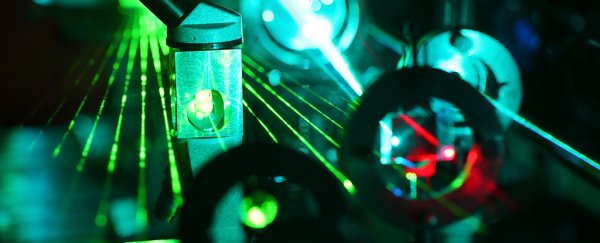Lasers powerful enough to tear the fabric of matter itself are being developed in a special laboratory in China, potentially giving scientists the chance to create and study experimental environments unlike anything we have on Earth.
The stats behind these lasers are impressive: One has already reached a peak of 5.3 million billion watts or petawatts (PW), which is around 500 times the power of all the world's electrical grids combined. There are plans to double that figure before 2018 is out, and yet these intense bursts of light last less than one trillionth of a second.
Meanwhile a new 100-PW laser is on the drawing board that could produce a pulse of light capable of ripping electrons and positrons (the antimatter counterparts to electrons) right out of empty space, showing that matter and energy are interchangeable – as Einstein so famously proposed with E=mc^2.
"That would be very exciting," the lead scientist on the project, physicist Ruxin Li, told Edwin Cartlidge at Science. "It would mean you could generate something from nothing."
Lasers work by stimulating electrons inside a lasing material, like a gas, a crystal, or a semiconductor. Photons emitted by the electrons emerge in a tightly aligned stream of light created at specific wavelengths.
As power equals energy divided by time, laser bursts can be boosted by increasing their energy or shortening their duration. In past years the focus has been on increasing the energy, but teams like the one in China are now looking at shortening pulse time as well.
That opens up new possibilities in everything from treating cancers with laser light to reproducing extreme temperatures and pressures to help understand how the Universe came into being.
The laser that holds the 5.3 petawatt record, the Shanghai Superintense Ultrafast Laser Facility (SULF), uses a cylinder of titanium-doped sapphire about the size of a frisbee to amplify light.
Pulses created by the crystal are bounced around a mirrored chamber, with many light frequencies that fleetingly reinforce each other before cancelling each other out. You're left with a very short, very powerful, laser pulse.
Despite all this power, SULF is compact enough to fit on the top of a table.
The new laser about to be constructed is the Station of Extreme Light (SEL), which Li and his team hope to get up and running by 2023. The idea is to use a second booster beam to increase the laser's power, and to replace the sapphire with a specially made, artificial crystal that maximises energy efficiency.
Extra intensity can also be achieved with a sharper focus – the SEL laser is intended to focus on an area just 3 micrometres (millionths of a metre) across.
Combined with the strength of a 100-PW laser, the level of intensity that would result in would be 1024 watts per square centimetre. That's 10 trillion trillion times more intense than sunlight hitting the Earth.
And that brings us back to ripping electrons and positrons out of empty space, or "breaking the vacuum" as it's sometimes called.
According to quantum electrodynamics, a vacuum isn't completely empty: electrons and positrons flicker briefly into existence before cancelling each other out, created from the uncertainty of quantum mechanics.
A super-short, super-powerful laser could grab those bits of matter before they collide and annihilate each other, scientists think, because of the electric field encircling the beam. That field could break the attraction between electron-positron pairs.
As those pairs were shaking, they would produce electromagnetic waves of their own in the form of gamma rays, generating new electron-positron pairs and a cascade of particles that we could detect. And that's when the science really gets interesting, say the experts.
"This will be completely new physics," Alexander Sergeev, president of the Russian Academy of Sciences, told Science.
